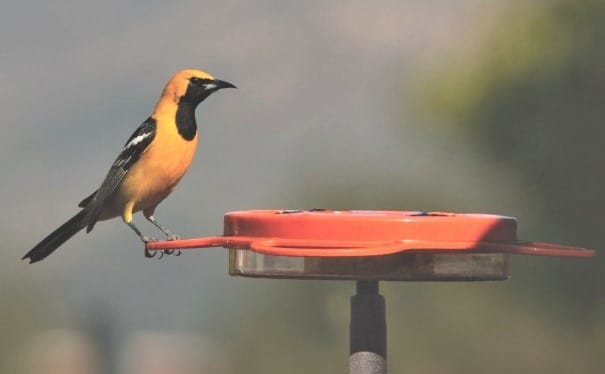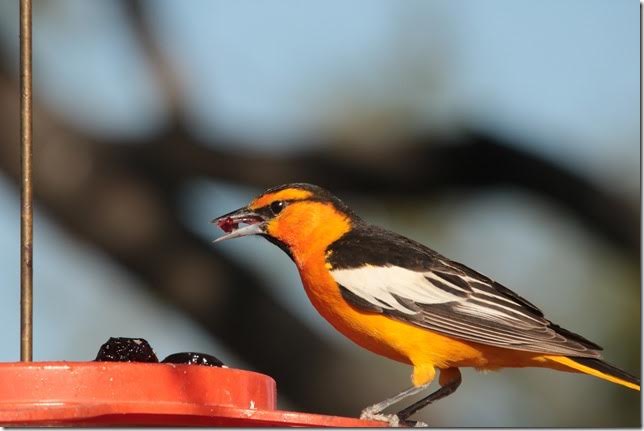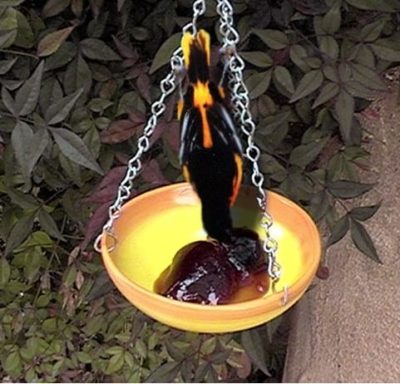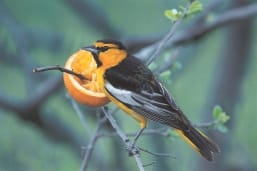This article is by special contributor Brad Brockman of Wild Birds Unlimited in Tucson, AZ.
Last week, as I was repotting plants on the front porch, I caught a bright flash of orange out of the corner of my eye. I knew instantly that it was a male oriole of some species.
It had been attracted to the bird feeders mounted on the wall near my kitchen window. One holds grape jelly, which many birds enjoy (I particularly like the verdins and grape jelly keeps them coming around all year!). The other feeder is a hummingbird feeder.
Both of these types of feeders are definitely enticing to an oriole passerby.
But there’s also an oriole-specific type of feeder and I realized that I had not yet put my oriole feeder out for the season.
I immediately rushed into the house and grabbed the oriole feeder, filled it with nectar, placed a daub of grape jelly on top, and ran it outside as fast as I could go. Orioles are here only part of the year so I do everything I can to entice them into my yard while they’re in Tucson!

When to See Orioles in Tucson
An unexpected, surprise visit is often the way folks encounter their first oriole. They are not a year-round species in Tucson, and their arrival is unpredictable.
Orioles go south for the winter and the “scouts” (male orioles) come back sometime in the spring to scope out and claim a nesting territory of their own.
In Tucson, their arrival can be anywhere from the end of January to early March.
While waiting for the females to arrive a few weeks later, the males will also claim several food sources that are close to their sacred territory.
By mid-September, orioles will have left the Tucson area to overwinter in warmer areas.
Common Oriole Species in Tucson
In the Tucson area, the most common species are the hooded oriole and bullocks oriole.
In the higher elevations around the city, like Vail and Catalina, you may also see the Scott’s oriole.

Bullocks Oriole at a birdfeeder
How to Attract Orioles
To attract orioles, timing is everything. Place your feeders out in mid-January, in case orioles make an early arrival that year. At Wild Birds Unlimited, we recommend simply keeping any oriole-friendly feeders up and running throughout the year, especially in winter. You’ll get lots of other interesting birds while you wait for the orioles.
 Some favorite foods that keep orioles interested in coming back to your feeders are:
Some favorite foods that keep orioles interested in coming back to your feeders are:
- nectar,
- grape jelly,
- live mealworms,
- orange halves, and
- pomegranates.
If your landscaping contains ocotillo, agaves, saguaros, and any other flowering, nectar-rich plants – even better. Orioles also appreciate the opportunity to gobble up any insect larva they can find so ease up on the pesticides.
Palms and yuccas make great nesting sites. To protect oriole nests, avoid palm trimming from March through August to avoid destroying any active nests!
Use an Oriole Nectar Feeder
I recommend starting out by offering nectar, then branching out to other foods from there. A convenient way to offer nectar is with an oriole feeder. Oriole nectar feeders are bright orange, mimicking the coloration of fruits they desire, such as oranges and papaya.
Orioles will readily drink the 4 to 1 water-to-sugar nectar formula you make for the hummingbirds. They will also drink a more dilute mix of 6 to 1. Feel free to use either one.
Proper placement of your oriole nectar feeder can be important in luring these birds into your yard. Remember, the birds have to see your offering when flying overhead so don’t hide it under a tree or awning. Place it out in the open, near your birdbath, right in the sun, so that orioles that happen to pass overhead can see the feeder down below!
Moving water is effective at luring the orioles as well.
Tucson’s orioles begin their migration south in August and are usually gone by mid-September. Seeing these beautiful, sometimes elusive songbirds is treat and well worth trying to attract into the yard.
Other Tips For Attracting and Feeding Tucson’s Orioles
- Start early. Mid-January is a good time. Our year-round hummingbirds love oriole feeders too so keep your oriole feeders going all year if you want.
- Use the same nectar recipe for orioles as you do for hummingbirds – four parts water to one part sugar. Change nectar twice a week, and don’t use food coloring.

- Stick with a sugar-water feeder specifically designed for orioles. Orioles often first try hummingbird feeders but their bills are usually too big, ending in frustration.
- Serve the grape jelly in an open dish or cup, and keep it fresh. Use grape jelly all year because it also attracts great birds like cardinals, pyrrhuloxia, cactus wrens, and even hummingbirds.
- Be patient. If you don’t attract orioles in your first year, keep at it. It can take several seasons to find a following.
You can find our review of Wild Birds Unlimited here.